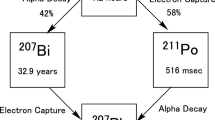Abstract
Objective
90Y-ibritumomab tiuxetan (Zevalin) which is used for the treatment of malignant lymphomas can be used for SPECT imaging based on bremsstrahlung from 90Y beta particles. However, gamma rays emitted by 111In, which is administered to evaluate the indication for the treatment, contaminate the 90Y bremsstrahlung images. Our objective is to investigate the influence of 111In on the 90Y SPECT images using Monte Carlo simulation.
Methods
We used an in-house developed simulation code for the Monte Carlo simulation of electrons and photons (MCEP). Two hot spheres with diameters of 40 mm were put in an elliptical phantom. Both spheres (“sphere 1” and “sphere 2”) were filled with 90Y and 111In mixed solutions. The activities of 90Y in sphere 1 and sphere 2 were 241 and 394 kBq/mL, respectively, and the ones of 111In were 8.14 and 13.3 kBq/mL, respectively. The background activity of 90Y was 38.6 kBq/mL, whereas that of 111In was 1.30 kBq/mL; moreover, the acquisition time was 30 min. Two energy windows were used: one is 90–190 keV included the 111In photopeak; the other is 90–160 keV. To evaluate the quality of the SPECT images, the contrast recovery coefficient (CRC) and the constant noise ratio (CNR) of the SPECT images were derived.
Results
For the energy window between 90 and 160 keV, the 111In count was 74 % of the total. In that case, the CRC values were 30.1 and 30.7 % for “sphere 1” and “sphere 2”, respectively, whereas the CNR values were 6.8 and 12.1, respectively. For the energy window between 90 and 190 keV, the 111In count reached 85 % of the total count. The CRC and CNR values were 38.6 and 40.0 % and 10.6 and 19.4, respectively.
Conclusions
Our simulation study revealed that the cross talk between 111In and 90Y in SPECT imaging is rather serious. Even for the energy window excluding the 111In photopeak, the count ratio of 90Y was less than 30 % of the total. However, the influence of 111In on 90Y-SPECT imaging cannot be ignored, and the count ratio because of 111In is important to estimate the density of 90Y.






Similar content being viewed by others
References
SPECTRUM™ PHARMACEUTICALS LLC and FUJIFILM RI Pharma Co., Ltd. Usefulness of “RI-labeled antibody therapy using Zevalin ®”. http://zevalin.jp/unmember/about2.html. Accessed 06 January 2016.
Minarik D, Gleisner KS, Ljungberg M. Evaluation of quantitative 90Y SPECT based on experimental phantom studies. Phys Med Biol. 2008;53:5689–703.
Ljungberg M, Gleisner KS. The accuracy of absorbed dose estimates in tumors determined by quantitative SPECT: a Monte Carlo study. Acta Oncol. 2011;50:981–9.
Rong X, Du Y, Ljungberg M, Rault E, Vandenberghe S, Frey EC. Development and evaluation of an improved quantitative 90Y bremsstrahlung SPECT method. Med Phys. 2012;39:2346–58.
Minarik D, Gleisner KS, Ljungberg M. Evaluation of quantitative planer 90Y bremsstrahlung whole-body imaging. Phys Med Biol. 2009;54:5873–83.
Elschot M, Lam MG, van den Bosch MA, Viergever MA, de Jong HW. Quantitative Monte Carlo-based 90Y SPECT reconstruction. J Nucl Med. 2013;54:1557–63.
Takahashi A, Himuro K, Yamashita Y, Komiya I, Baba S, Sasaki M. Monte Carlo simulation of PET and SPECT imaging of 90Y. Med Phys. 2015;42:1926–35.
Tanaka M, Uehara S, Kojima A, Matsumoto M. Monte Carlo simulation of energy spectra for 123I imaging. Phys Med Biol. 2007;52:4409–25.
Moore SC, Park MA, Cervo M, Miiller SP. A fast Monte Carlo-based forward projector with complete physics modeling of Y-90 bremsstrahlung. In: IEEE nuclear science symposium and medical imaging conference record (NSS/MIC); 2012. pp. 2699–701. doi:10.1109/NSSMIC.2012.6551614.
Wiseman GA, White CA, Stabin M, Dunn WL, Erwin W, Dahlbom M, et al. Phase I/II 90Y-Zevalin (yttrium-90 ibritumomab tiuxetan, IDEC-Y2B8) radioimmunotherapy dosimetry results in relapsed or refractory non-Hodgkin’s lymphoma. Eur J Nucl Med. 2000;27:766–77.
Minarik D, Gleisner KS, Linden O, Wingårdh K, Tennvall J, Strand S-E, et al. 90Y bremsstrahlung imaging for absorbed-dose assessment in high-dose radioimmunotherapy. J Nucl Med. 2010;51:1974–8.
Darrell RF, Sui S, Ruby FM. MIRD dose estimate report No. 20: radiation absorbed-dose estimates for 111In- and 90Y-ibritumomab tiuxetan. J Nucl Med. 2009;50:644–52.
Elschot M, Vermolen BJ, Lam MG, de Keizer B, van den Bosch MA, de Jong HW. Quantitative comparison of PET and bremsstrahlung SPECT for imaging the in vivo Yttrium-90 microsphere distribution after liver radioembolization. PLoS One. 2013;8:e55742. doi:10.1371/journal.pone.0055742.
Rhymer SM, Parker JA, Palmer MR. Detection of 90Y extravasation by bremsstrahlung imaging for patients undergoing 90Y-ibritumomab tiuxetan therapy. J Nucl Med. 2010;38:195–8.
Walrand S, Hesse M, Demonceau G, Pauwels S, Jamar F. Yttrium-90-labeled microsphere tracking during liver selective internal radiotherapy by bremsstrahlung pinhole SPECT: feasibility study and evaluation in an abdominal phantom. EJNMMI Res. 2011;1:1–14.
Carlier T, Eugène T, Bodet-Milin C, Garin E, Ansquer C, Rousseau C, et al. Assessment of acquisition protocols for routine imaging of Y-90 using PET/CT. EJNMMI Res. 2013;3:11.
Tapp KN, Lea WB, Johnson MS, Tann M, Fletcher JW, Hutchins GD. The impact of image reconstruction bias on PET/CT 90Y dosimetry after radioembolization. J Nucl Med. 2014;55:1452–8.
Cherry SR, Sorenson JA, Phelps ME. Physics in nuclear medicine. 3rd ed. Philadelphia: Saunders; 2003. p. 264–70.
Acknowledgments
The authors would like to thank Dr. Shuzo Uehara for providing the original simulation codes (HEXAGON and NAI) and a lot of valuable advice. We declare no conflict of interest for this study.
Author information
Authors and Affiliations
Corresponding author
Rights and permissions
About this article
Cite this article
Shiba, H., Takahashi, A., Baba, S. et al. Analysis of the influence of 111In on 90Y-bremsstrahlung SPECT based on Monte Carlo simulation. Ann Nucl Med 30, 675–681 (2016). https://doi.org/10.1007/s12149-016-1112-9
Received:
Accepted:
Published:
Issue Date:
DOI: https://doi.org/10.1007/s12149-016-1112-9




